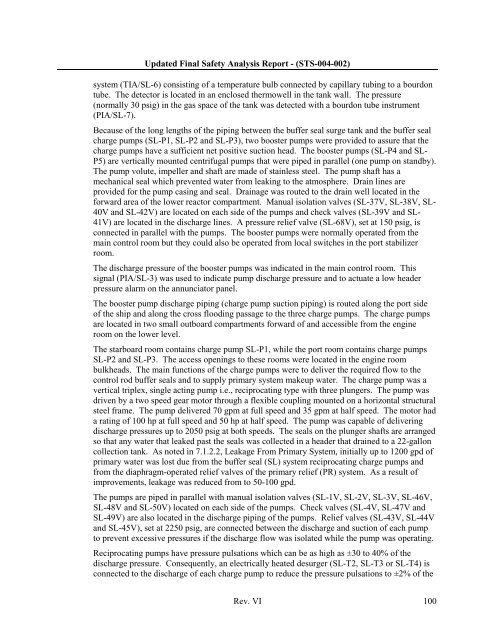10 CFR 50.71(e) - Maritime Administration - U.S. Department of ...
10 CFR 50.71(e) - Maritime Administration - U.S. Department of ...
10 CFR 50.71(e) - Maritime Administration - U.S. Department of ...
You also want an ePaper? Increase the reach of your titles
YUMPU automatically turns print PDFs into web optimized ePapers that Google loves.
Updated Final Safety Analysis Report - (STS-004-002)system (TIA/SL-6) consisting <strong>of</strong> a temperature bulb connected by capillary tubing to a bourdontube. The detector is located in an enclosed thermowell in the tank wall. The pressure(normally 30 psig) in the gas space <strong>of</strong> the tank was detected with a bourdon tube instrument(PIA/SL-7).Because <strong>of</strong> the long lengths <strong>of</strong> the piping between the buffer seal surge tank and the buffer sealcharge pumps (SL-P1, SL-P2 and SL-P3), two booster pumps were provided to assure that thecharge pumps have a sufficient net positive suction head. The booster pumps (SL-P4 and SL-P5) are vertically mounted centrifugal pumps that were piped in parallel (one pump on standby).The pump volute, impeller and shaft are made <strong>of</strong> stainless steel. The pump shaft has amechanical seal which prevented water from leaking to the atmosphere. Drain lines areprovided for the pump casing and seal. Drainage was routed to the drain well located in theforward area <strong>of</strong> the lower reactor compartment. Manual isolation valves (SL-37V, SL-38V, SL-40V and SL-42V) are located on each side <strong>of</strong> the pumps and check valves (SL-39V and SL-41V) are located in the discharge lines. A pressure relief valve (SL-68V), set at 150 psig, isconnected in parallel with the pumps. The booster pumps were normally operated from themain control room but they could also be operated from local switches in the port stabilizerroom.The discharge pressure <strong>of</strong> the booster pumps was indicated in the main control room. Thissignal (PIA/SL-3) was used to indicate pump discharge pressure and to actuate a low headerpressure alarm on the annunciator panel.The booster pump discharge piping (charge pump suction piping) is routed along the port side<strong>of</strong> the ship and along the cross flooding passage to the three charge pumps. The charge pumpsare located in two small outboard compartments forward <strong>of</strong> and accessible from the engineroom on the lower level.The starboard room contains charge pump SL-P1, while the port room contains charge pumpsSL-P2 and SL-P3. The access openings to these rooms were located in the engine roombulkheads. The main functions <strong>of</strong> the charge pumps were to deliver the required flow to thecontrol rod buffer seals and to supply primary system makeup water. The charge pump was avertical triplex, single acting pump i.e., reciprocating type with three plungers. The pump wasdriven by a two speed gear motor through a flexible coupling mounted on a horizontal structuralsteel frame. The pump delivered 70 gpm at full speed and 35 gpm at half speed. The motor hada rating <strong>of</strong> <strong>10</strong>0 hp at full speed and 50 hp at half speed. The pump was capable <strong>of</strong> deliveringdischarge pressures up to 2050 psig at both speeds. The seals on the plunger shafts are arrangedso that any water that leaked past the seals was collected in a header that drained to a 22-galloncollection tank. As noted in 7.1.2.2, Leakage From Primary System, initially up to 1200 gpd <strong>of</strong>primary water was lost due from the buffer seal (SL) system reciprocating charge pumps andfrom the diaphragm-operated relief valves <strong>of</strong> the primary relief (PR) system. As a result <strong>of</strong>improvements, leakage was reduced from to 50-<strong>10</strong>0 gpd.The pumps are piped in parallel with manual isolation valves (SL-1V, SL-2V, SL-3V, SL-46V,SL-48V and SL-50V) located on each side <strong>of</strong> the pumps. Check valves (SL-4V, SL-47V andSL-49V) are also located in the discharge piping <strong>of</strong> the pumps. Relief valves (SL-43V, SL-44Vand SL-45V), set at 2250 psig, are connected between the discharge and suction <strong>of</strong> each pumpto prevent excessive pressures if the discharge flow was isolated while the pump was operating.Reciprocating pumps have pressure pulsations which can be as high as ±30 to 40% <strong>of</strong> thedischarge pressure. Consequently, an electrically heated desurger (SL-T2, SL-T3 or SL-T4) isconnected to the discharge <strong>of</strong> each charge pump to reduce the pressure pulsations to ±2% <strong>of</strong> theRev. VI <strong>10</strong>0
















